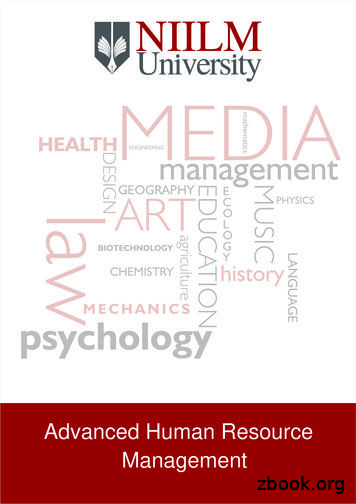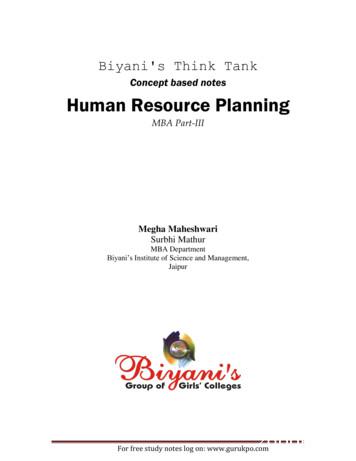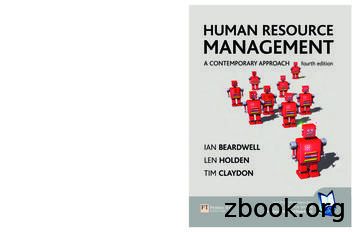Project Human Resource Management - PMstudy
Project Human Resource ManagementStudy NotesPMI, PMP, CAPM, PMBOK, PM Network and the PMI Registered Education Provider logo are registered marks of theProject Management Institute, Inc. 2012 PMstudy.com. All rights reserved
Points to Note Please read Chapter 9 from Project Management Institute, A Guide to the ProjectManagement Body of Knowledge, (PMBOK Guide) – Fourth Edition, Project ManagementInstitute, Inc., 2008 (pages 215-242). The study notes explain topics that are important for PMP exam preparation, and you canexpect several questions from these topics. It is very important to understand all the concepts discussed in this chapter, so please payclose attention to all the terms used. Try to relate the concepts to real life examples. After reading the study notes, please answer the chapter test questions in this knowledgearea. The chapter questions improve your understanding of the concepts discussed in thestudy notes. 2012 PMstudy.com. All rights reserved2
What is Project Human ResourceManagement? Processes that help project managers and other managers to organize, and manage all theproject stakeholders’ expectations. Processes that explain how to make the most effective use of the people involved with theproject, including all stakeholders. Major Human Resource Management processes are: Develop Human Resource Plan Acquire Project Team Develop Project Team Manage Project TeamPlease refer to figure 9-1, on page 217, in PMBOK Guide Fourth Edition, which provides anoverview of the processes in Project Human Resource Management. 2012 PMstudy.com. All rights reserved3
Develop Human Resource Plan Identifies and documents roles, responsibilities, required skills, and reporting relationships andcreates staffing management plan. The roles can be assigned to persons or to groups, whocould be part of the organization performing the project or external to it. Identifies the training needs, strategies for team building, programs to recognize and reward,and issues regarding safety and compliance. Is planned in the early stages in most projects. Is closely linked with Communications Planning, since the performing organization’s structurehas a major influence on the project’s human resource requirements. 2012 PMstudy.com. All rights reserved4
Human Resource Plan Output of Develop Human Resource Plan Part of the Project Management Plan Provides guidance on how we should define, staff, manage, control, and finally release projecthuman resources Should definitely include: Role and responsibility assignments: Project roles and responsibilities are closely linked to the Define Scope process. Roles (who does what), authority (who decides what), responsibility (work expected to beperformed), and competency (skill and capacity needed to complete the activities in theproject) are defined, and role clarity is documented for the project’s human resources. 2012 PMstudy.com. All rights reserved5
Human Resource Plan (continued)Staffing management plan: Describes when and how human resource requirements are met Can be formal/informal, highly detailed/broadly framed depending on the needs of the project Contains information on staff acquisition, resource calendars, staff release plan, trainingneeds, recognition and rewards, compliance, and safetyProject organization chart: Is a graphical display of project team members and their reporting relationships Can be formal/informal, highly detailed/broadly framed depending on the need of the projectFor details, please refer to PMBOK Guide Fourth Edition, page 222-223. 2012 PMstudy.com. All rights reserved6
Acquire Project Team In this process, human resource availability is confirmed, and the team necessary to completethe project is acquired. Points the project manager/project management team has to consider while acquiring theproject team: Effectively negotiate and influence those who can provide required human resources Failure to acquire the required human resources could affect the success of the project andcould even result in project cancellation Alternative resources, even if less competent, should be assigned if, for any reason, therequired human resources are not available. By so doing, no regulatory/legal/mandatory, orany other criteria should be violated The tools and techniques used for this process are: Pre-assignment Negotiation Acquisition Virtual teams 2012 PMstudy.com. All rights reserved7
Acquire Project Team (continued) The outputs for the Acquire Project Team process are: Project Staff Assignments: The project staff members are assigned, and the assignmentsare documented Resource Calendars: They document the time periods each member works on the project Project Management Plan Updates: The project management plan should be updated withhuman resource plan after completion of the above two sub-processes 2012 PMstudy.com. All rights reserved8
Develop Project Team Process that improves the competencies, interactions among the team members, and theoverall team environment to enhance project performance Objectives of developing a project team include: Enhance the skills and knowledge of team members Enhance a feeling of trust and agreement among team members Enhance cohesiveness among team members to improve both individual and teamproductivity 2012 PMstudy.com. All rights reserved9
Tools And Techniques For DevelopProject Team Interpersonal Skills Training Team Building Activities Ground Rules Co-location Recognition and Rewards For more details, please refer to PMBOK Guide Fourth Edition, pages 232-234. 2012 PMstudy.com. All rights reserved10
Manage Project Team Process to track team member performance, provide feedback, resolve issues, and managechanges to optimize project performance. Project team management achieves the following objectives: Change results are submitted Human resource plan is updated Issues are resolved Inputs for performance appraisals are provided Lessons learned document is added to the organization’s database The project management team should: Observe team behavior Manage conflict Resolve issues Appraise team members’ performance 2012 PMstudy.com. All rights reserved11
Tools and Techniques for ManageProject Team Observation and Conversation Project performance Appraisals Conflict Management Issue Log Interpersonal skillsFor more details, please refer to PMBOK Guide Fourth Edition, pages 238-241 2012 PMstudy.com. All rights reserved12
Maslow’s Hierarchy of NeedsSource: Project Management - A Systems Approach To Planning, Scheduling, And Controlling (pages195-196) 2012 PMstudy.com. All rights reserved13
Herzberg's Theory of Motivators andHygiene Factors Factors such as company policy, supervision, interpersonal relations, working conditions, andsalary are the hygiene factors. The absence of the hygiene factors can create jobdissatisfaction, but their presence does not guarantee motivation or satisfaction. Achievement, recognition, the work itself, responsibility, and advancement are motivators(satisfiers). They are associated with long-term positive effects in job performance. Thehygiene factors (dissatisfiers) consistently produce only short-term changes in job attitudesand performance. The satisfiers relate to what a person does, while the dissatisfiers relate to the situation inwhich the person does what he or she does. 2012 PMstudy.com. All rights reserved14
Handling Conflicts Blake and Mouton have delineated five modes for handling conflicts: Withdrawal: Retreat or withdraw from a potential disagreement Smoothing: De-emphasize or avoid areas of differences and emphasize areas ofagreement Compromising: Bargain and search for solutions that bring some degree of satisfaction tothe parties in a dispute Forcing: Exert one’s viewpoint at the potential expense of another—characterized bycompetitiveness and a win-lose situation Confrontation: Handling the conflict directly, which involves a problem solving approachwhereby affected parties work through their disagreements.Source: Project Management - A Systems Approach to Planning, Scheduling, and Controlling,pages 304, 305, and 306 2012 PMstudy.com. All rights reserved15
Conflict Intensity Most of the conflicts occur due to the following issues (in order of decreasing intensity)Highest Intensity Schedules Priorities Manpower Technical Procedures Personality CostsLowest IntensitySource: Project Management - A Systems Approach to Planning, Scheduling, and Controlling,page 302 2012 PMstudy.com. All rights reserved16
Management/Leadership Styles Some common management/leadership styles are: Autocratic: Manager makes decisions himself or herself- allows subordinates little involvement anddiscussion before a decision is made Laissez faire: Manager does not interfere with subordinates – so subordinates are largely unsupervised,which may lead to anarchy Democratic: Manager allows subordinates to discuss issues and reach decisions, although he or she willguide and advise Discussing: There is two-way communication and discussion between manager and subordinates Directing: Managers tell people what tasks will be performed and when and how they should be done Delegating: Manager delegates to get consensus on what has been achieved and what needs to be done Coaching: Manager issues instructions to others Facilitating: Manager coordinates inputs from several sources before making a decision Participatory Supportive Task oriented Team-based Assertive 2012 PMstudy.com. All rights reserved17
Types of Roles People Play in a Project Destructive Roles Supportive Roles Aggressor Information Seekers Dominator Information Givers Devil’s Advocate Encouragers Topic Jumper Clarifiers Recognition Seeker Harmonizers Withdrawer Consensus Takers Blocker Gate Keepers InitiatorsReference: A Systems Approach to Planning, Scheduling, and Controlling (pages 181-182) 2012 PMstudy.com. All rights reserved18
Delegation A method and style of management by which the project manager distributes responsibility forproper performance of a task to a team member working on the project. Project manager, even after delegating responsibility to a team member, still retains theultimate responsibility for the end results. Project manager also agree to be held accountable for the decision to delegate. Involves: Giving responsibility (obligation to perform the assigned tasks)Gaining acceptance (the team member's agreement to be responsible)Granting authority (the right and power to accomplish the tasks)Expecting reliability (assurance of best and consistent effort)Requiring accountability (accepting responsibility for success or failure).Please note: The concept and process of delegation can be illustrated by the "4D's" model(Drop, Delay, Delegate, and Do). 2012 PMstudy.com. All rights reserved19
Delegation (continued ) Project managers should delegate: Routine tasks Tasks that require technical expertise What someone else can do better Projects involving the critical, visible issues of quality, quantity, cost, and timeliness to selfmanaged project teams or self-directed teams. Project managers should not fully delegate: Long range planning (although they should involve others) Selection, monitoring, motivation, evaluation (performance appraisal) and rewarding of key teamplayers Personal matters Practical method for effective delegation: There are eight essential ingredients of effective delegation, which can be represented by theacronym: 2 x ETFP, which stands for Easy To Follow Procedures. Effective and successfuldelegation involves four steps, each having two major ingredients. E Entrust and Enlist T Teach and Touch F Familiarize and Follow up P Praise (the Process) and Participate (in Feedback) 2012 PMstudy.com. All rights reserved20
Delegation (continued ) The project manager must assign responsibility, grant appropriate authority, expect reliability,and require accountability from the delegatees. Authority confers the right to impose some degree of obedience. Responsibility confers the obligation on the delegatee to act with or without detailed guidanceor specific authorization. Reliability encompasses two main factors—track record and quality of work. Accountability in the project context is the extent to which individuals are answerable and mustprovide visible evidence of their actions.Reference: Organizing Projects for Success (Human Aspects of Project Management) by VijayVerma. Chapter 4: Important Issues in Project Organizational Design 2012 PMstudy.com. All rights reserved21
Delegation (continued ) 2012 PMstudy.com. All rights reserved22
6 Human Resource Plan (continued) Staffing management plan: Describes when and how human resource requirements are met Can be formal/informal, highly detailed/broadly framed depending on the needs of the project Contains information on staff acquisition, resource calendars, staff release plan, training needs, recognition and rewards, compliance, and safety
Understanding PMstudy Process Chart Please refer to the PMstudy Process Chart which has been provided in the PMP-prep course. This is a brain-dump and should be jotted down from memory within the first 20 minutes of PMP exam.
Human Resource Management Human Resource Policy QUADRANT-I Module 4: Human Resource Policy 1. Learning Outcome 2. Definition 3. Employee understanding on HR Policy 4. Benefits of policy 5. Specific Personal policies 6. Responsibility for policy making 7. Formulation of Human Resource Policy 8. Principles 9. Procedures 10. Programs 11. Summary 1.
Human Resource Management Question Answer Bank MBA-203 Q.1 What is Human Resource Management Human Resource Management is a process, which consists of four main activities, namely, acquisition, development, motivation, as well as maintenance of human resources. Scott, Clothier and Spriegel have defined Human Resource Management as that
1.1.2 Evolution of Human Resource Management 1.1.3 Human Resource Management: Nature 1.1.4 Human Resource Management: Scope 1.1.5 Human Resource Management: Objectives 1.2 Functions of HRM 1.3 Growing Importance of HRM Functions 1.3.1 Factors Contributing to the Growing Importance of HRM 1.4 Concepts and Essential of Management
Ans Human resource planning can be defined as the process of identifying the number of people required by an organization in terms of quantity and quality. All human resource management activities start with human resource planning. So we can say that human resource planning is the principle/primary activity of human resource management.
human resource functions while keeping them satisfied in their work. It covers a wide range of chapters on human resource management such as human resource functions, performance management and human resource development and empowerment. This module serves the purpose of a resource handbook for carrying out training on Human Resource Management
Human resource management: the state of the debate 24 Summary 27 Activity 28 References and further reading 29 2 Strategic human resource management Nicky Golding 32 Objectives 32 Introduction to strategic human resource management 32 Understanding the business context 34 Approaches to the strategy-making pr
Introduction to Groups, Rings and Fields HT and TT 2011 H. A. Priestley 0. Familiar algebraic systems: review and a look ahead. GRF is an ALGEBRA course, and specifically a course about algebraic structures. This introduc-tory section revisits ideas met in the early part of Analysis I and in Linear Algebra I, to set the scene and provide motivation. 0.1 Familiar number systems Consider the .























